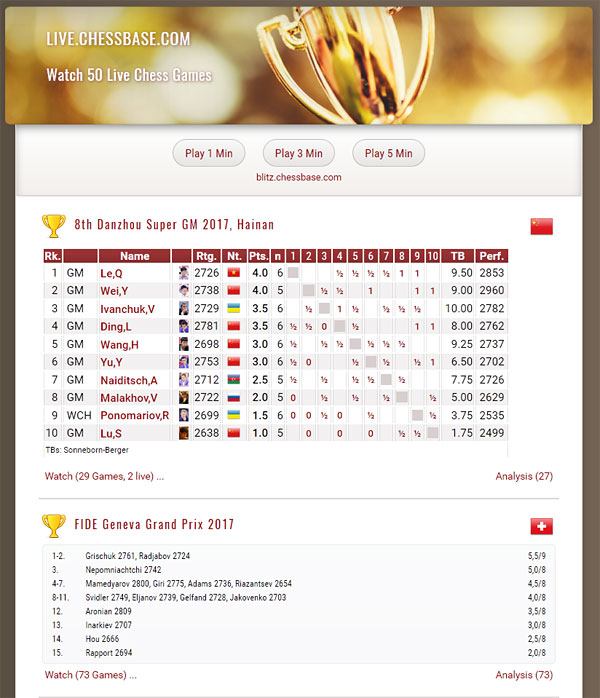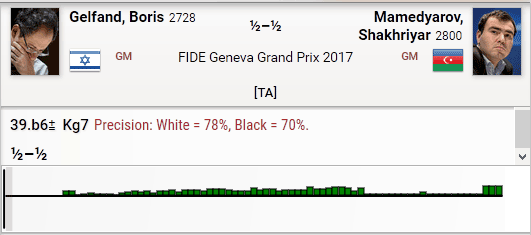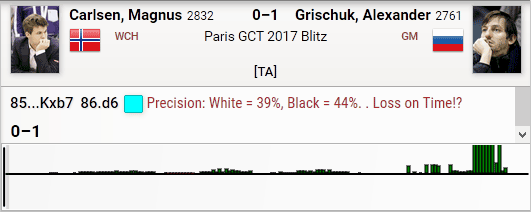Live.ChessBase.com
 As you probably know by now: our Live Broadcast screen provides the moves of games as they unfold in different parts of the world. You can see the events that are currently running in the right navigation on the news page. Clicking on any one of the tournaments — the ones with the radio tower icon are currently being broadcast — will take you to a game board were the moves appear.
As you probably know by now: our Live Broadcast screen provides the moves of games as they unfold in different parts of the world. You can see the events that are currently running in the right navigation on the news page. Clicking on any one of the tournaments — the ones with the radio tower icon are currently being broadcast — will take you to a game board were the moves appear.
You can also click on "Live Tournaments" for an overview:

On this screen you will usually find cross tables or current standings. Clicking on an event, on the front page or in the overview, will load the tournament.

Clicking on a game will transfer it to the main board. While they are being played — and certainly afterwards — the most important games of the round are analysed and annotated by a very powerful computer, in real-time. The machine analysis includes didactic opening notes, tactical analysis, threats, better lines — all given in natural language.

At the bottom of the notation window on the right there is an evaluation bar which indicates how the game went for the two players. You can simply click on the bar to jump to the position where things came to a head. There are also buttons for editing, if you want to (delete, promote, cut lines, unannotate, undo, redo), save and play out the position against Fritz or tweet it to others. Hovering the mouse over any button will show you its function. The Live Book section shows you the moves that have been played in the current position, by what level of players and with what results. The Live Book is the most comprehensive and up-to-date openings key in the world.

You can maximize the replayer, auto-play, flip the board and save all games in the bar below the board. You can access the live games at any time during the round. To the right of our news page you have the live tournament navigation.
Precision measurement
There is one feature that many have not noticed, and some not fully understood: the "precision" data given at the end of annotated games. It tells us what percentage of moves are ones the computer would also play. Mind you, this is not mechanically counted: the program only considers move that were played after the opening phase, and more importantly: only non-obvious move. For instance necessary recaptures are not part of the precision count, only moves where there is a genuine non-forced choice.
Let us look at some precision measurements from recent events:

Round 1 of FIDE Geneva Grand Prix 2017: both players showing a high level of precision

In this Geneva game you can see who was playing precisely and who was not

The computer approves: the highest level of precision we saw in this event

Very high precision from the World Champion in round 3 of the recent blitz in Paris

Round four blitz: Magnus won in 24 moves, after very imprecise play by Mamedyarov

In the round five Blitz Carlsen was ground down and lost on time

In the same round Wesley So was defeated after considerable imprecision
Let us take a look at some recent tournaments. Here are some tables that give the percentage of (unforced) moves that match the ones played by the stongest chess engines. In some cases, where the game was a short, uninteresting draw, the system did not undertake machine analysis, and in such cases there is no precision data. We have listed the values for the top players in the final standings, two very strong players (Aronian, Gelfand) who did not do so well, and the players at the bottom of the table.
FIDE Geneva Grand Prix 2017
| Player/rd |
R1 |
R2 |
R3 |
R4 |
R5 |
R6 |
R7 |
R8 |
R9 |
Aver. |
| Radjabov |
73% |
86% |
59% |
85% |
- |
74% |
97% |
- |
73% |
80.0% |
| Grischuk |
79% |
81% |
- |
83% |
- |
48% |
76% |
64% |
71% |
71.7% |
| Nepomniachtchi |
45% |
- |
47% |
57% |
77% |
68% |
54% |
79% |
74% |
62.6% |
| Mamedyarov |
70% |
71% |
38% |
- |
- |
53% |
67% |
65% |
- |
60.7% |
| Giri |
28% |
60% |
70% |
70% |
61% |
- |
- |
75% |
69% |
72.2% |
| Svidler |
71% |
71% |
- |
78% |
93% |
69% |
55% |
59% |
85% |
72.6% |
| Gelfand |
78% |
- |
- |
76% |
- |
68% |
60% |
49% |
72% |
67.1% |
| Aronian |
55% |
62% |
68% |
72% |
80% |
31% |
- |
25% |
84% |
59.6% |
| Rapport |
70% |
51% |
63% |
32% |
61% |
34% |
71% |
32% |
- |
51.75% |
| Hou Yifan |
31% |
58% |
77% |
32% |
40% |
69% |
79% |
48% |
58% |
54.7% |
| Salem |
52% |
43% |
59% |
81% |
54% |
42% |
42% |
56% |
31% |
51.1% |
After nine rounds the final standings were as follows:
|
Rk |
SNo |
|
Name |
FED |
Rtg |
Pts |
| 1 |
12 |
GM |
Radjabov Teimour |
AZE |
2724 |
6,0 |
| 2 |
4 |
GM |
Grischuk Alexander |
RUS |
2761 |
5,5 |
| |
6 |
GM |
Nepomniachtchi Ian |
RUS |
2742 |
5,5 |
| 4 |
2 |
GM |
Mamedyarov Shakhriyar |
AZE |
2800 |
5,0 |
| |
3 |
GM |
Giri Anish |
NED |
2775 |
5,0 |
| |
5 |
GM |
Svidler Peter |
RUS |
2749 |
5,0 |
| |
8 |
GM |
Harikrishna Pentala |
IND |
2737 |
5,0 |
| |
9 |
GM |
Adams Michael |
ENG |
2736 |
5,0 |
| |
10 |
GM |
Li Chao B |
CHN |
2735 |
5,0 |
| |
17 |
GM |
Riazantsev Alexander |
RUS |
2654 |
5,0 |
| 11 |
1 |
GM |
Aronian Levon |
ARM |
2809 |
4,5 |
| |
7 |
GM |
Eljanov Pavel |
UKR |
2739 |
4,5 |
| |
11 |
GM |
Gelfand Boris |
ISR |
2728 |
4,5 |
| |
14 |
GM |
Jakovenko Dmitry |
RUS |
2703 |
4,5 |
| 15 |
13 |
GM |
Inarkiev Ernesto |
RUS |
2707 |
4,0 |
| 16 |
15 |
GM |
Rapport Richard |
HUN |
2694 |
2,5 |
| |
16 |
GM |
Hou Yifan |
CHN |
2666 |
2,5 |
| 18 |
18 |
GM |
Salem A.R. Saleh |
UAE |
2638 |
2,0 |
Let us turn to the evaluation of precision in blitz games:
Next Move GCT 2017-Blitz, Leuven (1st half)
| Player/% |
R1 |
R2 |
R3 |
R4 |
R5 |
R6 |
R7 |
R8 |
R9 |
Aver. |
Pts |
| Carlsen |
56 |
57 |
75 |
63 |
- |
63 |
35 |
57 |
74 |
60.0% |
7.5 |
| Giri |
25 |
72 |
39 |
44 |
38 |
82 |
66 |
38 |
58 |
51.3% |
5.5 |
| Vachier-l. |
44 |
88 |
50 |
46 |
30 |
39 |
79 |
62 |
37 |
52.8% |
4.5 |
| Kramnik |
38 |
59 |
48 |
37 |
62 |
64 |
44 |
58 |
54 |
51.6% |
6.0 |
| Aronian |
41 |
62 |
42 |
65 |
79 |
27 |
39 |
23 |
46 |
47.1% |
4.5 |
Above are the precision values for the top players in the first half of the Grand Chess Tour Blitz section in Leuven. In the first round Carlsen (56%) defeated Anand (41%). In round two Aronian (62%) beat Ivanchuk (23%), in round three Carlsen (75%) had black against Vachier Lagrave (50%) and won in 60 moves. In the same round Ivanchuk (62%) had a great advantage over Giri (39%) but lost on time. In round four Carlsen (63%) beat Ivanchuk (28%) in just 22 moves, and in round six Carlsen (63%) beat Aronian (27%) in 60 moves. In round seven Carlsen (35%) lost to Giri (66%), and in round eight Aronian (23%) lost to Anand (84%).
For the second half of the Blitz we show you individual games that stood out, with the precision data and the result for each of them.
Next Move GCT 2017-Blitz, Leuven (2nd half)
| White |
Black |
Rnd |
wP |
bP |
Res |
| Carsen |
Anand |
R10 |
74% |
69% |
draw |
| Aronian |
Vachier |
R10 |
38% |
47% |
0-1 |
| Nepomniachtchi |
Ivanchuk |
R10 |
28% |
62% |
0-1 |
| Giri |
Kramnik |
R10 |
68% |
62% |
draw |
| Jobava |
Wesley So |
R10 |
18% |
54% |
0-1 |
| Kramnik |
Carlsen |
R11 |
19% |
68% |
0-1 |
| Vachier-L. |
Giri |
R11 |
69% |
76% |
draw |
| Anand |
Wesley So |
R11 |
81% |
39% |
1-0 |
| Ivanchuk |
Carlsen |
R12 |
19% |
68% |
0-1 |
| Carlsen |
Vachier |
R13 |
70% |
24% |
1-0 |
| Wesley So |
Kramnik |
R13 |
70% |
89% |
draw |
| Aronian |
Nepomniachtchi |
R13 |
29% |
30% |
1-0 |
| Giri |
Ivanchuk |
R13 |
50% |
67% |
draw |
| Jobava |
Anand |
R13 |
63% |
42% |
draw |
Conclusion: Precise, but human
You can spend hours (as we have just done) following the precision evaluations, looking for trends and patterns. I would like to mention that the system is being used to identify suspicious performances — in some proven cases of cheating in the past our internal checks have revealed that the accused players were consistantly scoring above 90% in their games. The above values, however, strongly suggest that there is no cheating going on, at least not at this level of tournament play. Everything looks completely plausible: players vacillate between very high scores in one game and very low precision values in subsequent games.
We hope you enjoy this feature, and as always welcome your feedback, questions, and suggestions on how to improve it and make it more useful.
At the airport, in the hotel or at home on your couch: with the new ChessBase you always have access to the whole ChessBase world: the new ChessBase video library, tactics server, opening training App, the live database with eight million games, Let’s Check and web access to playchess.com


















 As you probably know by now: our Live Broadcast screen provides the moves of games as they unfold in different parts of the world. You can see the events that are currently running in the right navigation on the news page. Clicking on any one of the tournaments — the ones with the radio tower icon are currently being broadcast — will take you to a game board were the moves appear.
As you probably know by now: our Live Broadcast screen provides the moves of games as they unfold in different parts of the world. You can see the events that are currently running in the right navigation on the news page. Clicking on any one of the tournaments — the ones with the radio tower icon are currently being broadcast — will take you to a game board were the moves appear.















